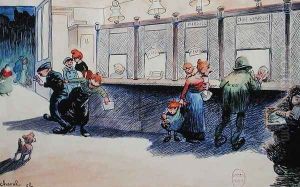Joseph Ferdinand Cheval Paintings
Joseph Ferdinand Cheval was born on April 19, 1836, in the small village of Charmes-sur-l'Herbasse in the Drôme region of France. He was a French postman who is renowned for spending thirty-three years of his life building an extraordinary palace, which is often regarded as an exemplary work of naïve art architecture. Cheval's work was not initially recognized by the artistic community and was discovered by the avant-garde and surrealists as an outstanding instance of outsider art only after his death.
Cheval began his career as a rural postman. While on his mail routes, he would collect stones and carry them home to start constructing what would become known as the 'Palais Idéal' (Ideal Palace). He claimed to have tripped over an unusual stone in 1879 and was inspired by its shape to collect more stones for a building project. Cheval spent the next three decades dedicating his free time to building his Ideal Palace. He worked at night, under the light of an oil lamp, often in secret to avoid the ridicule of his neighbors, using the stones he collected on his postal rounds.
The Palais Idéal is a remarkable structure, combining a mix of different styles, including Hindu, Egyptian, and medieval architecture, with sculptures and carvings of animals, mythical creatures, and biblical scenes. Cheval bound the stones together with lime, mortar, and cement. Initially, the public and the authorities perceived his work as the bizarre obsession of a village eccentric. However, with time, his vision gained recognition for its creativity and sheer persistence.
Towards the end of his life, artists and intellectuals began to praise Cheval's work. In 1912, the writer André Breton, known for his work with the Surrealist movement, wrote an essay that celebrated the Palais as a masterpiece of naïve art. Cheval continued to work on his project until his death on August 19, 1924. He had also spent the last eight years of his life building his own mausoleum in the Hauterives cemetery, determined that his body would not rest in an 'ordinary' grave.
Today, the Palais Idéal is recognized as a significant work of outsider art and is protected as a historical monument by the French government. It attracts visitors from around the world and stands as a testament to human creativity and perseverance. Cheval's work has influenced artists across various disciplines and continues to inspire those who see in it the realization of a singular and undeterred vision.
